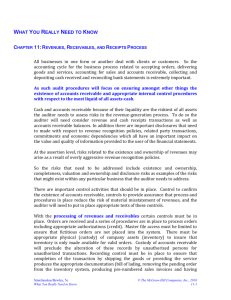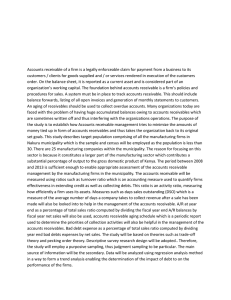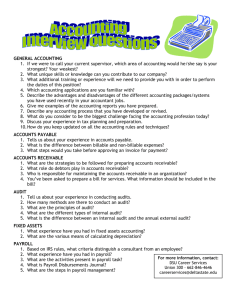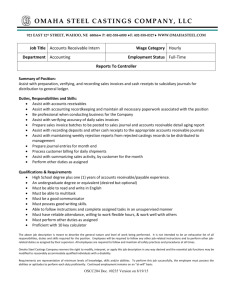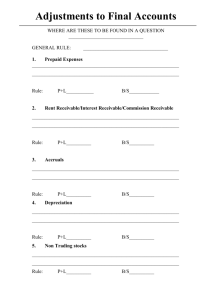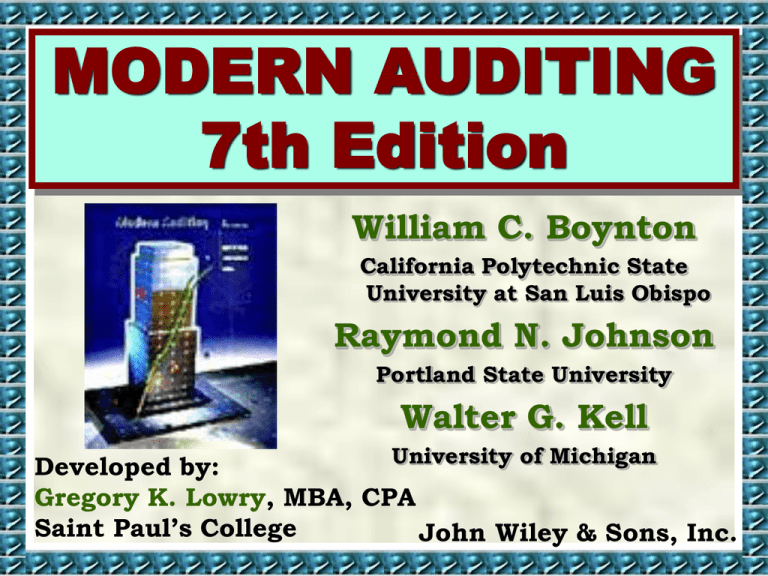
MODERN AUDITING
7th Edition
William C. Boynton
California Polytechnic State
University at San Luis Obispo
Raymond N. Johnson
Portland State University
Walter G. Kell
University of Michigan
Developed by:
Gregory K. Lowry, MBA, CPA
Saint Paul’s College
John Wiley & Sons, Inc.
CHAPTER 14
AUDITING THE REVENUE CYCLE
Nature of the Revenue Cycle
Control Activities — Credit Sales
Transactions
Control Activities — Cash Receipts
Transactions
Control Activities — Sales
Adjustment Transactions
Substantive Tests of Accounts
Receivable
Value-Added Services
Nature of the Revenue Cycle
An entity’s revenue cycle consists of
activities related to the exchange of goods
and services with customers and to the
collection of the revenue in cash.
For a merchandising company, the classes of
transactions in the revenue cycle include:
1. credit sales (sales made on accounts),
2. cash receipts (collections on accounts and
cash sales), and
3. sales adjustments (discounts, sales
returns and allowances, and uncollectable
accounts [provisions and writeoffs]).
The Revenue Cycle
Figure 14-1
Revenue
Transaction
Debit
Credit
Credit Sales
Accounts Receivable
Cost of Goods Sold
Sales
Inventory
Cash Receipts
Cash
Sales Discounts
Accounts Receivable
Sales Returns and Allowances
Sales Returns and
Allowances
Accounts Receivable
Provision for Bad Debts
Bad Debt Expense
Allowance for
Uncollectable Accounts
Writeoff of Bad Debts
Allowance for
Uncollectable Accounts
Accounts Receivable
Nature of the Revenue Cycle
Understanding the Client’s Business and Industry
Auditors develop audit strategy based on the risk of
material misstatement. The first step in assessing risk
is obtaining an understanding of the client’s business
and industry because it assists the auditor in:
1. Developing an expectation of total revenues by
understanding the client’s capacity, market place, and
clients.
2. Developing an expectation of gross margin by
understanding the client’s market share and
competitive advantage in the market place.
3. Developing an expectation of net receivables based
on the average collection period for the client and
industry.
Selected Specific Audit Objectives for the
Revenue Cycle
Figure 14-2
Assertion
Category
Existence or
Occurrence
Transaction
Class or
Balance
Transaction
Specific
Audit
Objective
Recorded sales transactions represent goods shipped
or services provided during the period.
Recorded cash receipt transactions represent cash
received during the period.
Recorded sales adjustment transactions during the
period represent authorized discounts, returns and
allowances, and uncollectable accounts.
Completeness
Balance
Accounts receivable representing amounts owed by
customers exists at the balance sheet date.
Transaction
All sales, cash receipts, and sales adjustments made
during the period were recorded.
Balance
Accounts receivable include all claims on customers
at the balance sheet date.
Assertion
Category
Rights and
Obligations
Valuation or
Allocation
Transaction
Class or
Balance
Specific
Audit
Objective
Transaction
The entity has rights to the receivables and cash
resulting from recorded revenue cycle transactions.
Balance
Accounts receivable at the balance sheet date
represent legal claims of the entity on customers for
payment.
Transaction
All sales and cash receipts and sales adjustments are
valued using GAAP and correctly journalized,
summarized, and posted.
Balance
Accounts receivable represent gross claims on
customers at the balance sheet date and agree with
the sum of the accounts receivable subsidiary ledger.
The allowance for uncollectable accounts represents
a reasonable estimate of the difference between gross
receivables and their net realizable value.
Assertion
Category
Presentation
and Disclosure
Transaction
Class or
Balance
Specific
Audit
Objective
Transaction
The details of sales, cash receipts, and sales
adjustments support their presentation in the
financial statements including their classification
and related disclosures.
Balance
Accounts receivable are properly identified and
classified in the financial statements.
Appropriate disclosures have been made concerning
accounts receivable that have been assigned or
pledged.
Nature of the Revenue Cycle
Materiality
Revenues are a measure of volume of
activity for virtually every entity. Revenues
usually have a high volume of transactions
and total revenues are so important to the
financial statements that they are often
used as a gauge of overall materiality for the
engagement. Revenues also give rise to
accounts receivable and eventually cash and
cash flow from operations. The accounts
receivable produced by credit sales
transactions are almost always material to
the balance sheet.
Nature of the Revenue Cycle
The transaction classes and account
balances comprising the revenue cycle
normally have material effects on the
financial statements. To enhance the
auditor’s effectiveness and efficiency in
meeting specific audit objectives in this
cycle, careful attention should be given to
considering inherent risk, analytical
procedures risk, and control risk when
choosing the audit strategy for each audit
objective.
Nature of the Revenue Cycle
Inherent Risk
In assessing inherent risk for revenue cycle assertions,
the auditor should consider pervasive factors that may
affect assertions in several cycles, including the revenue
cycle, as well as factors that may pertain only to specific
assertions in the revenue cycle. These include factors
that might motivate management to misstate revenue
cycle assertions, such as:
1. Pressures to overstate revenues in order to report
achieving announced revenue or profitability targets
or industry norms that were not achieved in reality
owing to such factors as global, national, or regional
economic conditions, the impact of technological
developments on the entity’s competitiveness, or poor
management.
Nature of the Revenue Cycle
2. Pressures to overstate cash and gross receivables or
understate the allowance for doubtful accounts in
order to report a higher level of working capital in the
face of the need to meet debt covenants.
Nature of the Revenue Cycle
Other factors that might contribute to
misstatements in revenue cycle assertions include
the following:
1. The volume of sales, cash receipts, and sales
adjustment transactions is often high, resulting
in numerous opportunities for errors to occur.
2. The timing and amount of revenue to be
recognized may be contentious owing to factors
such as ambiguous accounting standards, the
need to make estimates, the complexity of the
calculations involved, and purchasers’ rights of
return.
3. When receivables are factored with recourse, the
correct classification of the transaction as a sale
or a borrowing may be contentious.
Nature of the Revenue Cycle
4. Receivables may be misclassified as current or
noncurrent owing to difficulties in estimating the
likelihood of collection within the next year or
the source of events on which collection is
contingent.
5. Cash receipt transactions generate liquid assets
that are particularly susceptible to
misappropriation.
6. Sales adjustment transactions may be used to
conceal thefts of cash received from customers by
overstating discounts, recording fictitious sales
returns, or writing off customers’ balances as
uncollectable.
Nature of the Revenue Cycle
Analytical Procedures Risk
Analytical procedures risk is the element of detection
risk that analytical procedures will fail to detect material
misstatements. Analytical procedures are cost effective
and rely on the auditor’s knowledge of the business and
industry. They are not only effective in identifying
potential misstatements in the financial statements, but
they are also effective in identifying issues that may
result in providing value-added services in addition to
the audit report.
The first step in performing analytical procedures is
obtaining an understanding of total revenues given:
1. the client’s capacity and
2. the client’s market place for those products.
Nature of the Revenue Cycle
The auditor should obtain an understanding
of the client’s capacity, the maximum
volume of sales that it could generate if it
fully utilized its facilities and employees to
manufacture and deliver products or
services. Auditors should be sensitive to the
volume of sales that an entity records given
its capacity, the number of shifts that an
entity operates, and seasonal variations in
the industry. It is much more effective to
evaluate total revenues against a measure of
business activity than comparing current
revenues with prior-year revenues.
Nature of the Revenue Cycle
One important analytical procedure is
understanding the client’s market share,
which compares the client’s revenues with
total revenues in the market for the client’s
product. This is particularly important
because companies with dominant market
shares often obtain premium gross margins.
Finally, it is important for the auditor to
evaluate the client’s accounts receivable
turn days, or average collection period, and
be able to compare the collection period
with industry norms.
Analytical Procedures Commonly Used to
Audit the Revenue Cycle
Figure 14-3
Ratio
Formula
Audit
Significance
Sales to Capacity
Net Sales ÷ Nonfinancial
Measure of Capacity
Helpful in assessing the
reasonableness of total revenues.
Market Share
Client’s Net Sales ÷ Net Sales
of Industry
Helpful in assessing the
reasonableness of both total
revenues and gross margins.
Larger market share is often
associated with larger gross
margins.
Sales to Total
Assets
Sales ÷ Average Total Assets
This ratio is useful for
manufacturing and other
asset-based companies.
Describes the relationship
between assets and sales
revenues.
Accounts
Receivable
Growth to Sales
Growth
((Accounts Receivable n ÷
Accounts Receivable n-1) 1) ÷ ((Sales n ÷ Sales n-1) – 1)
Ratios larger than 1.0 indicate
that receivables are growing
faster than sales. Large ratios
may indicate possible collection
problems.
Ratio
Formula
Audit
Significance
Accounts
Receivable Turn
Days
Average Accounts Receivable ÷
Sales x 365
Useful in comparing with industry
averages. Longer collection
periods may indicate collection
problems. Prior experience and
current sales volumes may be
useful in estimating current net
receivables.
Uncollectable
Accounts Expense
to Net Credit
Sales
Uncollectable Accounts
Expense ÷ Net Sales
Useful in evaluating the
reasonableness of uncollectable
accounts expense. Smaller ratios
may indicate an inadequate
provision for uncollectable
accounts.
Uncollectable
Accounts Expense
to Accounts
Receivable
Writeoffs
Uncollectable Accounts
Expense ÷ Actual Accounts
Receivable Writeoffs
Useful in evaluating the
reasonableness of uncollectable
accounts expense. Smaller ratios
may indicate an inadequate
provision for uncollectable
accounts.
New Product
Revenues to Total
Revenues
Revenues from New Products
Introduced During the Year ÷
Total Revenues
Companies with a high proportion
of revenues from new products
may earn a premium gross
margin due to the ability to
innovate.
Nature of the Revenue Cycle
Control Environment
The control environment consists of
several factors that might mitigate
several of the inherent risks related to
the revenue cycle. In addition, these
factors may enhance or negate the
effectiveness of other internal control
components in controlling the risk of
misstatements in revenue cycle
assertions.
Nature of the Revenue Cycle
Risk Assessment
Management’s risk assessment for
financial reporting purposes is similar to
the external auditor’s assessment of
inherent risk. A conscientious effort on
management’s part to identify the kinds
of risks related to revenue cycle
transactions and balances, together with
a commitment to initiate control
activities to address those risks, should
reduce the risk of misstatements.
Nature of the Revenue Cycle
Information and Communication (Accounting
System)
Our primary concern with this component pertains
to the portion of the accounting system used in
processing cycle transactions and balances. An
understanding of the revenue accounting system
requires knowledge of how:
1. sales are initiated,
2. goods and services are delivered,
3. receivables are recorded,
4. cash is received, and
5. sales adjustments are made, including the
methods of data processing and the key
documents and records used.
Nature of the Revenue Cycle
Monitoring
This component should provide management with
feedback as to whether internal control pertaining to
revenue cycle transactions and balances are operating as
intended. The auditor should obtain an understanding of
this feedback and whether management has initiated any
corrective actions based on the information received
from the monitoring activities. Possibilities include
information received from:
1. customers concerning billing errors,
2. regulatory agencies concerning disagreements on
revenue recognition policies or related internal
control matters, and
3. External auditors concerning reportable conditions or
material weaknesses in relevant internal controls
found in prior audits.
Nature of the Revenue Cycle
Initial Assessments of Control Risk and
Preliminary Audit Strategy
The auditor’s procedures to obtain an understanding
of the 4 internal control components extend to the
design of policies and procedures and whether they
have been placed in operation. In the process of
obtaining an understanding of these 4 components,
the auditor may become aware of additional control
activities related to an assertion. However, the
procedures performed to obtain an understanding
may not extend to determining the effectiveness of
such controls. Without evidence about the
effectiveness of how internal controls are placed in
operation, the auditor’s initial assessment of control
risk must be at the maximum.
Control Activities —
Credit Sales Transactions
Sales orders may be taken over-the-counter,
via telephone, mail order, traveling sales
representatives, fax, or electronic data
interchange. The goods may be picked up by
the customer or shipped by the seller. Sales
transactions are usually recorded using
computer systems that may process
transactions in either a real-time or batch
processing mode. Control activities over
sales transactions should be tailored to
these varying circumstances.
Control Activities —
Credit Sales Transactions
Virtually every company that requires an
audit has a computerized accounting
system. Recall that there are 2 types of
computer controls:
1. General controls that relate to the
computer environment and have a
pervasive effect on computer applications.
2. Application controls that relate to the
individual computerized accounting
applications, such as the expenditure
cycle.
Control Activities —
Credit Sales Transactions
Consideration is given to procedures
used by the auditor to:
1. obtain and document an
understanding of internal control
and
2. perform tests of controls used to
make a final assessment of
control risk for purchase
transactions.
Control Activities —
Credit Sales Transactions
Common Documents and Records
The numerous documents and records used by large
companies in processing credit sales transactions
often include the following:
1. Customer order. Request for merchandise by a
customer received directly from the customer or
through a salesperson. May be a form furnished by
the seller or the buyer’s purchase order form.
2. Sales order. Form showing the description,
quantity, and other data pertaining to a customer
order. It serves as the basis for initiating the
transaction and internal processing of the customer
order by the seller.
Control Activities —
Credit Sales Transactions
3. Shipping Document. Form used to show the details
and date of each shipment. It may be in the form
of a bill of lading, which serves as a formal
acknowledgment of the receipt of goods for delivery
by a freight carrier. Other shipping documents may
include a packing slip with details on the items
included in a shipment.
4. Sales invoice. Form stating the particulars of a
sale, including the amount owed, terms, and date of
sale. It is used to bill customers and provides the
basis for recording the sale.
5. Authorized price list. Listing or computer master
file containing authorized prices for goods offered
for sale.
Control Activities —
Credit Sales Transactions
6. Sales transactions file. Computer file of
completed sales transactions. Used to
print the sales invoices and sales journal,
and update the accounts receivable,
inventory, and general ledger master files.
7. Sales journal. Journal listing completed
sales transactions.
8. Customer master file. Contains the
customer’s shipping and billing information
and the customer’s credit limit.
Control Activities —
Credit Sales Transactions
9. Accounts Receivable master file. Contains
information on transactions with, and the
balance due from, each customer. Serves as
the basis for the accounts receivable
subsidiary ledger.
10. Customer monthly statement. Report sent
to each customer showing the beginning
balance, transactions during the month, and
the ending balance.
Control Activities —
Credit Sales Transactions
Functions
The processing of revenue transactions
involves the following revenue
functions:
1. Initiating sales. The request by an
entity for a sales transaction with
another entity, including:
a. Accepting customer orders.
b. Approving credit.
Control Activities —
Credit Sales Transactions
2. Delivery of goods and services. The
physical shipment or delivery of a good
or service, including:
a. Filling sales orders.
b. Shipping sales orders.
3. Recording sales. The formal
recognition of revenue by an entity,
including:
a. Billing customers.
b. Recording sales.
Control Activities —
Credit Sales Transactions
Obtaining an Understanding and Assessing
Control Risk
The auditor should obtain an understanding of
the sales cycle that is sufficient to plan the
audit. That is, the auditor needs to have a
sufficient understanding to be able to:
1. identify the types of potential
misstatements,
2. consider factors that affect the risk of
material misstatements, and
3. design substantive tests.
Control Activities —
Credit Sales Transactions
Tests of controls provide the means for determining the
effectiveness of such controls. The extent of the
auditor’s consideration of factors related to assessing
control risk for any given assertion depends on audit
strategy.
If the auditor plans to assess control risk at moderate or
high, he or she might use the knowledge about the
effectiveness of revenue cycle controls obtained while
understanding internal control. The auditor might also
infer about the effectiveness of programmed controls by
evaluating the operating effectiveness of computer
general controls and by making inquiries and inspecting
documents related to procedures used to follow up on
exception reports generated by programmed controls.
Control Activities —
Credit Sales Transactions
If the auditor plans to assess control risk at
low for revenue cycle assertions, he or she will
usually have to:
1. Test the effectiveness of general controls.
2. Use computer-assisted audit techniques
(CAATs) to evaluate the effectiveness of
programmed controls.
3. Test the effectiveness of procedures to
follow-up on exceptions identified by
programmed controls.
Control Activities —
Cash Receipts Transactions
Common Documents and Records
Important documents and records used in processing
cash receipts include the following:
1. Remittance advice. Document mailed to the
customer with the sales invoices to be returned
with the payment showing the customer’s name
and account number, invoice number, and amount
owed.
2. Prelist. Listing of cash receipts received through
the mail.
3. Cash count sheets. Listing of cash and checks in a
cash register. Used in reconciling total receipts
with the total printed by the cash register.
Control Activities —
Cash Receipts Transactions
4. Daily cash summary. Report showing total
over-the-counter and mail receipts received by the
cashier for deposit.
5. Validated deposit slip. Listing prepared by the
depositor and stamped by the bank showing the date
and total of a deposit accepted by the bank and the
detail of receipts comprising the deposit.
6. Cash receipts transactions file. Computer file of
validated cash receipts transactions accepted for
processing; used to update the accounts receivable
master file.
7. Cash receipts journal. Journal listing cash receipts
from cash sales and collections on accounts
receivable.
Control Activities —
Cash Receipts Transactions
Functions
The cash receipts function, which
includes the processing of receipts
from cash and credit sales, involves
the following subfunctions:
1. Receiving cash receipts
2. Depositing cash in bank
3. Recording the receipts
Control Activities —
Cash Receipts Transactions
Obtaining an Understanding and Assessing
Control Risk
The auditor’s responsibilities and methodology
for meeting the requirements of the second
standard of fieldwork for cash receipts
transactions are the same as described for
credit sales transactions. Many control
procedures involved in processing cash receipts
are manual controls rather than programmed
control procedures.
Control Activities —
Sales Adjustment Transactions
Sales adjustment transactions involve the
following:
1. Granting cash discounts
2. Granting sales returns and allowances
3. Determining uncollectable accounts
In many companies, the number and dollar
value of these transactions is considerable. Of
primary concern is the possibility of fictitious
sales adjustment transactions being recorded to
conceal irregularities in processing cash
receipts.
Control Activities —
Sales Adjustment Transactions
The auditor performs tests of controls to obtain
evidence about the effective design and operation of
an entity’s system of internal control. The inherent
risk associated with cash receipts transactions is
high due to the possibility of employee fraud
through the diversion of cash receipts. If analytical
procedures show an increase in the number of days
that receivables are outstanding, one possible
explanation would be the diversion of cash receipts.
Due to the inherent risk of misappropriation of
cash, and the impact of cash receipts transactions
on receivables, the auditor will often test control
procedures related to cash receipts.
Control Activities —
Sales Adjustment Transactions
If the auditor plans to assess control risk as moderate or
high, the auditor will likely support the control risk
assessment with evidence accumulated while obtaining
the understanding of internal control.
If the auditor plans to assess control risk as low, the
auditor will expand the extensiveness of tests that
include inspection of documents and reperformance of
manual controls. If the control objective is achieved
through programmed control procedures, the auditor
plans a scope of tests that includes tests of:
1. computer general controls,
2. computer application controls, and
3. The effectiveness of manual follow-up procedures.
Substantive Tests of
Accounts Receivable
Receivables include amounts due from customers,
employees, and affiliates on open accounts, notes,
and loans, and accrued interest on such balances.
Our main consideration is directed at gross
receivables due from customers on credit sales
transactions and the related contra account, the
allowance for uncollectable accounts. The sales that
are most likely to represent potential
misstatements are the uncollected sales. To design
substantive tests for these accounts, the auditor
must first determine the acceptable level of tests of
details risk for each significant related assertion.
Substantive Tests of
Accounts Receivable
Determining Detection Risk for Tests of
Details
For a specified level of audit risk, tests of
details risk is inversely related to the assessed
levels of inherent risk, analytical procedures
risk, and control risk. Therefore, factors
pertaining to these assessments must be
considered in determining the acceptable level
of tests of details risk for each accounts
receivable assertion.
Substantive Tests of
Accounts Receivable
Pervasive inherent risk factors relating to gross and
net receivables as well as the revenue cycle were
previously discussed. The combined effects of these
factors, especially those contributing to the risk of
credit sales being overstated and the allowance for
uncollectable accounts being understated, may
result, respectively, in high assessments of inherent
risk for the existence or occurrence and valuation or
allocation assertions for gross accounts receivable
and the valuation or allocation assertion for the
related allowance account. Even when this is the
case, lower inherent risk assessment may be
appropriate for the other assertions.
Substantive Tests of
Accounts Receivable
Control risk assessments for
accounts receivable assertions
are dependent on the related
control risk assessments for
the transaction classes (credit
sales, cash receipts, and sales
adjustments) that affect the
accounts receivable balance.
Substantive Tests of
Accounts Receivable
The appropriate planned assessed levels of inherent
risk, analytical procedures risk, and control risk are
used in the audit risk model in the planning phase to
arrive at the appropriate planned level of tests of
details risk and the associated planned level of
substantive tests embodied in the preliminary audit
strategy for each assertion. If the actual or final
assessment differs from the planned assessment, the
audit risk model is used again with the actual data to
determine a revised acceptable level of tests of details
risk and an associated revised level of substantive
tests for each assertion. Either the planned levels, if
supported, or the revised levels are used in completing
the design of appropriate substantive tests.
Correlation of Risk Components —
Accounts Receivable Assertions
Figure 14-8
Existence
or
Occurrence
Completeness
Rights
and
Obligations
Valuation
or
Allocation
Presentation
and
Disclosure
Audit Risk
Low
Low
Low
Low
Low
Inherent Risk
Max
Moderate
Moderate
Max
Moderate
Moderate
Low
Moderate
Moderate
High
Control Risk
— Credit
Sales
Transactions
Low
Moderate
Moderate
Low
Moderate
Control Risk
— Cash
Receipt
Transactions
Low
Moderate
Moderate
Low
Moderate
Control Risk
— Sales
Adjustment
Transactions
Moderate
Moderate
Moderate
Low
Moderate
Combined
Control Risk
Moderate
Moderate
Moderate
Low
Moderate
Acceptable
Tests of
Details Risk
Moderate
High
High
Moderate
Moderate
Risk
Component
Analytical
Procedures
Risk
Substantive Tests of
Accounts Receivable
Designing Substantive Tests
The next step is to finalize the audit
program to achieve the specific audit
objective for each category of account
balance assertions. The specific
objectives addressed are the ones
listed in the Account Balance Audit
Objectives column of Figure 14-9.
Correlation of Risk Components —
Accounts Receivable Assertions
Figure 14-9
Category
Initial
Procedures
Substantive
Test
1. Obtain an understanding of
the business and industry and
determine:
a. The significance of revenues
and accounts receivable to
the entity.
b. Key economic drivers that
influence the entity’s sales,
margins, and collections.
c. Standard trade terms in the
industry, including
seasonal dating, collections
period, etc.
d. The extent of concentration
of activity with customers.
Account Balance Audit Objectives
EO4
C4
RO3
VA#
PD#
5
4,5
Category
Initial
Procedures
Substantive
Test
2. Perform initial procedures on
accounts receivable balance
and records that will be
subjected to further testing.
a. Trace beginning balance for
accounts receivable to prior
year’s working papers.
b. Review activity in general
ledger account for accounts
receivable and investigate
entries that appear unusual
in amount or source.
c. Obtain accounts receivable
trial balance and determine
that it accurately
represents the underlying
accounting records by:
Footing the trial balance
and determining
agreement with (1) the
total of the subsidiary
ledger or accounts
receivable master file,
and (2) the general ledger
balance.
Testing agreement of
customer and balances
listed on the trial balance
with those included in
the subsidiary ledger or
master file.
Account Balance Audit Objectives
EO4
C4
RO3
VA#
PD#
4,5
Category
Analytical
Procedures
Substantive
Test
3. Perform analytical procedures:
a. Develop an expectation for
accounts receivable using
knowledge of the entity’s
business acitvity, market
share, normal trade terms,
and its history of accounts
receivable turn days.
b. Calculate ratios:
Compare sales to the
entity’s capacity.
Compare sales growth
and receivalbes growth.
Accounts receivable turn
days.
Uncollectable accounts
expense to net credit
sales.
Uncollectable accounts
expense to accounts
receivable writeoffs.
c. Analyze ratio results relative
to expectations based on
prior years, industry data,
budgeted amounts, or other
data.
Account Balance Audit Objectives
EO4
C4
RO3
VA#
PD#
4,5
Category
Tests of
Details of
Transactions
Substantive
Test
4. Vouch a sample of recorded
sales and receivable
transactions to supporting
documentation.
a. Vouch receivable debits to
supporting sales invoices,
shipping documents, and
sales orders.
b. Vouch receivable credits
to remittance advises or
sales adjustments,
authorizations for sales
returns and allowances
or uncollectable account
writeoffs.
Account Balance Audit Objectives
EO4
C4
RO3
VA#
PD#
4
Category
Tests of
Details of
Transactions
Substantive
Test
5. Perform cutoff tests for sales
and sales returns.
a. Select a sample of
recorded sales
transactions from several
days before and after
year-end and examine
supporting sales invoices
and shipping documents
to determine if sales were
recorded in the proper
period.
b. Select sample of credit
memos issued after
year-end, examine
supporting
documentation such as
dated receiving reports
and determine that
returns were recorded in
the proper period. Also
consider whether volume
of sales returns after
year-end suggest the
possibility of
unauthorized shipments
before year-end.
Account Balance Audit Objectives
EO4
C4
RO3
VA#
PD#
Category
Tests of
Details of
Transactions
Substantive
Test
6. Perform cash receipts cutoff
tests.
a. Observe that all cash
received through the
close of business on the
last day of the fiscal year
is included in cash on
hand or deposits in
transit and that no
receipts of the
subsequent period are
included, or
b. Review documentation
such as daily cash
summaries, duplicate
deposit slips, and bank
statements covering
several days before and
after year-end for proper
cutoff.
Account Balance Audit Objectives
EO4
C4
RO3
VA#
PD#
Category
Tests of
Details of
Balances
Substantive
Test
7. Confirm accounts receivable.
a. Determine the form, timing,
and extent of confirmation
requests.
b. Select and execute sample
and investigate exceptions.
c. For positive confirmation
requests for which no reply
was received, perform
alternative follow-up
procedures:
Vouch subsequent cash
receipts identifiable with
items comprising
the account balance at
the confirmation date to
supporting
documentation.
Vouch items comprising
the balance at the
confirmation date to
documentary support
such as sales orders and
shipping documents.
Account Balance Audit Objectives
EO4
C4
RO3
VA#
PD#
4
Category
Tests of
Details of
Balances:
Accounting
Estimates
Substantive
Test
8. Evaluate the adequacy of the
allowance component for each
aging category and in the
aggregate.
a. Foot and crossfoot the aged
trial balance of receivables
and agree the total to the
general ledger.
b. Test aging by vouching
amounts in aging categories
for sample of accounts to
supporting documents.
c. For past due accounts:
Examine evidence of
collectability such as
correspondence with
customers and outside
collection agencies,
credit reports, and
customers’ financial
statements.
Discuss the collectability
of accounts with the
appropriate management
personnel.
d. Evaluate management’s
process for estimating the
allowance for doubtful
accounts using hindsight.
e. Evaluate the adequacy of
the allowance given
information about:
Industry trends.
Aging trends.
Collection history for
specific customers.
Account Balance Audit Objectives
EO4
C4
RO3
VA#
PD#
5
Category
Required
Procedures
Presentation
and
Disclosure
Substantive
Test
Account Balance Audit Objectives
EO4
C4
RO3
VA#
PD#
9. Confirmation of accounts
receivable included in step
7.
10. Compare statement
presentation with GAAP.
a. Determine that
receivables are properly
identified and classified
as to type and expected
period of realization.
b. Determine whether there
are credit balances that
are significant in the
aggregate and that
should be reclassified as
liabilities.
c. Determine the
appropriateness of
disclosures and
accounting for related
party, pledged, assigned,
or factored receivables.
4
4,5
Substantive Tests of
Accounts Receivable
Confirm Receivables
Confirmation of accounts receivable
involves direct written communication
between individual customers and the
auditor. This substantive test is used
extensively by the auditor.
Substantive Tests of
Accounts Receivable
Generally Accepted Auditing Procedures
The confirmation of receivables is a generally
accepted auditing procedure. AU 330, The
Confirmation Process (SAS 67), states that there
is an presumption that the auditor will request
the confirmation of receivables during an audit
unless:
1. Accounts receivable are immaterial to the
financial statements.
2. The use of confirmations would be ineffective
as an audit procedure.
Substantive Tests of
Accounts Receivable
3. The auditor’s combined assessment of
inherent risk and control risk is low and that
assessment, in conjunction with evidence
expected to be provided by analytical
procedures or other substantive tests of
details, is sufficient to reduce audit risk to an
acceptably low level for the applicable
financial statement assertions. In many
situations, both confirmation of accounts
receivable and other substantive tests of
details are necessary to reduce audit risk to
an acceptably low level of the applicable
financial statement assertions.
Substantive Tests of
Accounts Receivable
Forms of Confirmation
There are 2 forms of confirmation
request:
1. the positive confirmation, which
requires the debtor to respond whether
or not the balance shown is correct,
and
2. the negative confirmation, which
requires the debtor to respond only
when the balance shown is incorrect.
Value-Added Services
Generally accepted auditing standards do
not require that the auditor perform
value-added services. However, many
auditors develop industry specializations
so that they can understand industry
trends and better identify risks
associated with financial statements not
presenting fairly financial position,
results of operations, or cash flows. The
client and its board of directors usually
want to take full advantage of the
auditor’s knowledge.
Value-Added Services
In the process of performing the audit, the auditor may
benchmark company performance against others in the
industry. The auditor might address, for example,
whether:
1. The company is effectively utilizing assets to generate
sales based on a ratio of sales to total assets.
2. Receivables are growing faster than sales, thereby
consuming valuable cash flows.
3. The company has appropriately addressed risks
associated with a changing or maturing market place.
4. The company is bringing successful new product
innovations to market and is enjoying a high
percentage of revenues from new products, relative to
the competition.
CHAPTER 14
AUDITING THE REVENUE CYCLE
Copyright
Copyright 2001 John Wiley & Sons, Inc. All rights
reserved. Reproduction or translation of this work
beyond that permitted in Section 117 of the 1976
United States Copyright Act without the express
written permission of the copyright owner is
unlawful. Request for further information should
be addressed to the Permissions Department, John
Wiley & Sons, Inc. The purchaser may make backup
copies for his/her own use only and not for
distribution or resale. The Publisher assumes no
responsibility for errors, omissions, or damages,
caused by the use of these programs or from the
use of the information contained herein.

